1995 OLDSMOBILE SILHOUETTE towing
[x] Cancel search: towingPage 92 of 390
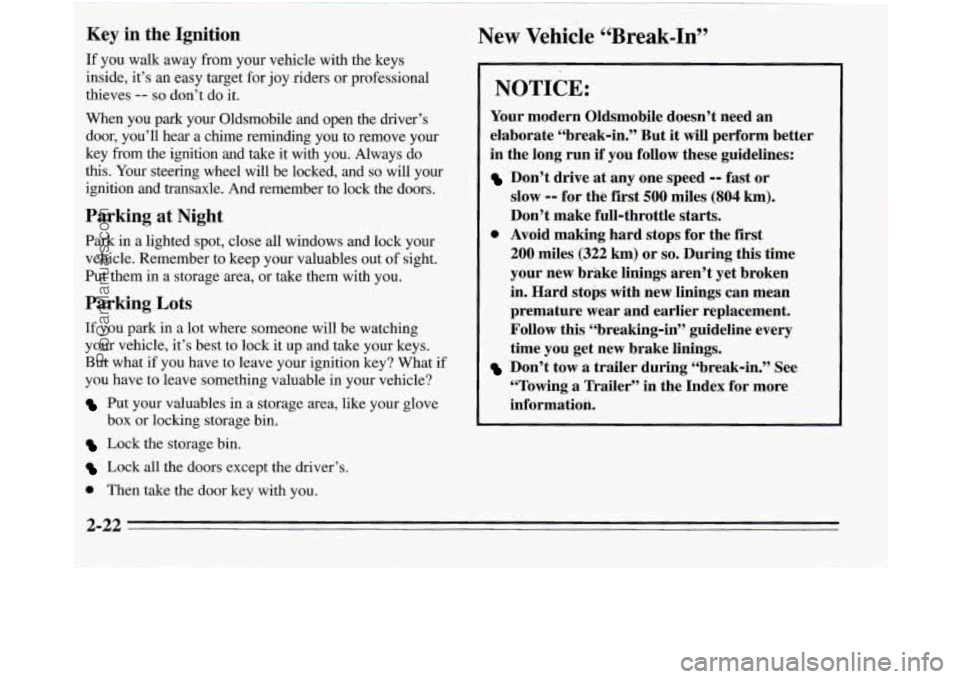
Key in the Ignition
If you walk away from your vehicle with the keys
inside, it’s an easy target for joy riders or professional
thieves
-- so don’t do it.
New Vehicle ''Break-in"
When you park your Oldsmobile and open the driver’s
door’ you’ll hear a chime reminding you to remove your
key from the ignition and take it with you. Always
do
this. Your steering wheel will be locked, and so will your
ignition and transaxle. And remember to lock the doors.
Parking at Night
Park in a lighted spot, close all windows and lock your
vehicle. Remember to keep your valuables out
of sight.
Put them in a storage area, or take them with you.
Parking Lots
If you park in a lot where someone will be watching
your vehicle, it’s best to lock it up and take your keys.
But what if you have to leave your ignition key? What if
you have
to leave something valuable in your vehicle?
Put your valuables in a storage area, like your glove
box or locking storage bin.
Lock the storage bin.
Lock all the doors except the driver’s.
0 Then take the door key with you.
NOTICE:
Your modern Oldsmobile doesn’t need an
elaborate “break-in.” But it
will perform better
in the long run if you follow these guidelines:
Don’t drive at any one speed -- fast or
slow
-- for the first 500 miles (804 km).
Don’t make full-throttle starts.
200 miles (322 km) or so. During this time
your new brake linings aren’t yet broken
in. Hard stops with new linings can mean
premature wear and earlier replacement.
Follow this “breaking-in” guideline every
time you get new brake linings.
Don’t tow a trailer during “break-in.” See
“Towing
a Trailer” in the Index for more
information.
0 Avoid making hard stops for the first
2-22
ProCarManuals.com
Page 95 of 390
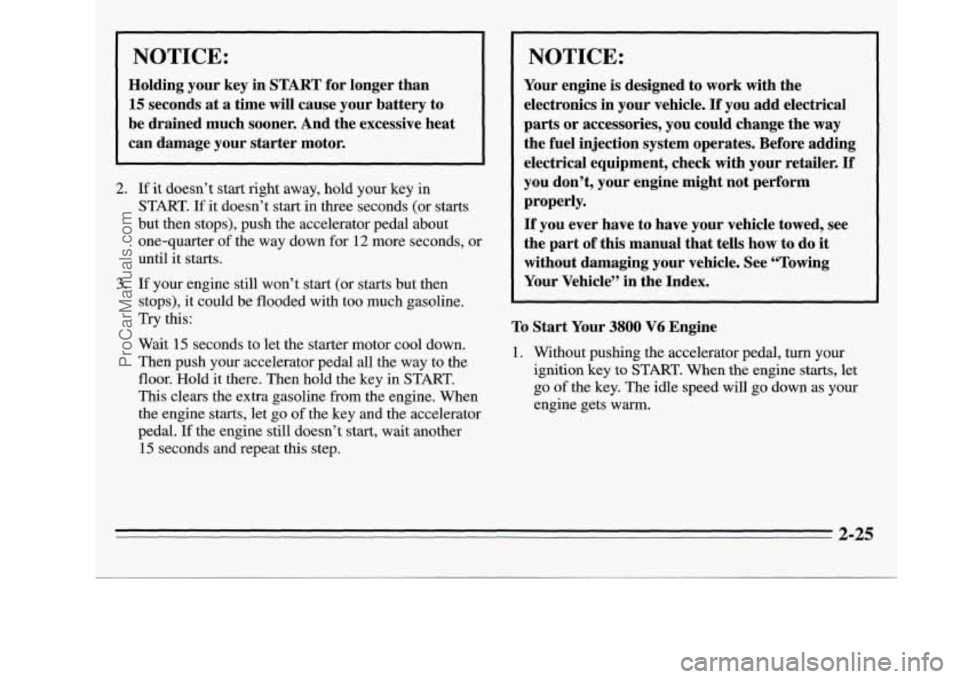
NOTICE:
Holding your key in START for longer than
15 seconds at a time will cause your battery to
be drained much sooner. And the excessive heat
can damage your starter motor.
2. If it doesn’t start right away, hold your key in
START.
If it doesn’t start in three seconds (or starts
but then stops), push the accelerator pedal about
one-quarter of the way down for
12 more seconds, or
until it starts.
3. If your engine still won’t start (or starts but then
stops), it could
be flooded with too much gasoline.
Try this:
Wait
15 seconds to let the starter motor cool down.
Then push your accelerator pedal all the way to the
floor. Hold it there. Then hold the key in START.
This clears the extra gasoline from the engine. When
the engine starts, let
go of the key and the accelerator
pedal.
If the engine still doesn’t start, wait another
15 seconds and repeat this step.
NOTICE:
Your engine is designed to work with the
electronics in your vehicle.
If you add electrical
parts or accessories, you could change the way
the fuel injection system operates. Before adding
electrical equipment, check with your retailer.
If
you don’t, your engine might not perform
properly.
If you ever have to have your vehicle towed, see
the part of this manual that
tells how to do it
without damaging your vehicle. See “Towing
Your Vehicle” in the Index.
To Start Your 3800 V6 Engine
1. Without pushing the accelerator pedal, turn your
ignition
key to START. When the engine starts, let
go of the key. The idle speed will go down as your
engine gets
warm.
2-25
ProCarManuals.com
Page 96 of 390
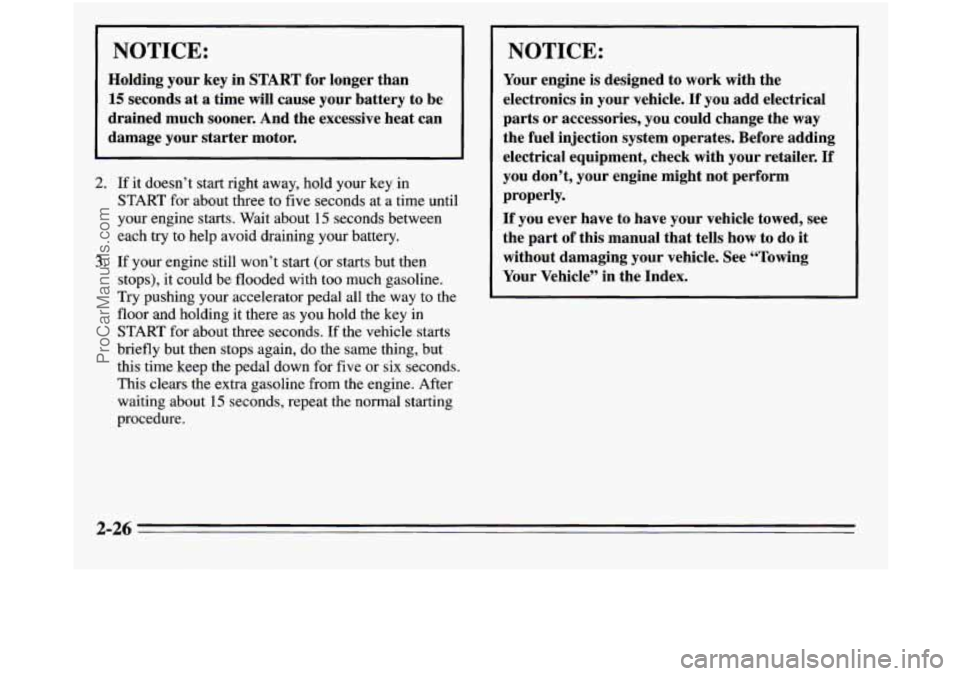
NOTICE:
Holding your key in START for longer than
15 seconds at a time will cause your battery to be
drained much sooner. And the excessive heat can
damage your starter motor.
2. If it doesn’t start right away, hold your key in
START
for about three to five seconds at a time until
your engine starts. Wait about
15 seconds between
each try to help avoid draining your battery.
3. If your engine still won’t start (or starts but then
stops), it could be flooded with too much gasoline.
Try pushing your accelerator pedal all the way
to the
floor and holding it there as you hold the key in
START for about three seconds. If the vehicle starts
briefly but then stops again, do the same thing, but
this time keep the pedal down for five or six seconds.
This clears the extra gasoline from the engine. After
waiting about
15 seconds, repeat the normal starting
procedure.
NOTICE:
Your engine is designed to work with the
electronics in your vehicle.
If you add electrical
parts or accessories, you could change the
way
the fuel injection system operates. Before adding
electrical equipment, check with your retailer.
If
you don’t, your engine might not perform
If you ever have to have your vehicle towed, see
the part of this manual that tells how to do
it
~ without damaging your vehicle. See “Towing
Your Vehicle” in the Index.
, properly.
2-26
ProCarManuals.com
Page 101 of 390

If your automatic transaxle has OVERDRIVE (@),
NOTICE: THIRD (D) is like OVERDRIVE (D), but you never go
into Overdrive. Here are some times you might choose
This NOTICE applies only if you have the 3800 THIRD (D) instead of OVERDRIVE (@):
V6 engine and the automatic overdrive transaxle.
If your vehicle is so equipped, and if it seems to 0 When driving on hilly, winding roads.
start up rather slowly, or if it seems not to shift
far that way, your vehicle can be damaged. So, if
When going down a steep hill. with a transaxle system sensor. If you drive very
between gears. gears as you go faster, something may be wrong
When towing a trailer, so there is less shifting
this happens, have your vehicle serviced right SECOND GEAR (2): This position
gives you
away. Until then, you can use SECOND (2) when more power, but lower fuel economy. You can use
SECOND
(2) on hills. It can help control your speed as you are driving less than 35 mph (56 km/h) and you go down steep mountain roads, but then you would
OVERDRIVE (0) for higher speeds. also want to use your brakes off and on.
THIRD GEAR (D): If your automatic transaxle does
not have
OVERDRIVE (@), this position is for normal
driving, at all speeds, in most street and highway
situations. NOTICE:
Don’t drive in SECOND (2) for more than 5 miles
(8 km), or at speeds over 55 mph (88 km/h), or
you can damage your transaxle. Use THIRD (D)
(OVERDRIVE (a) or THIRD (D) if your vehicle
has OVERDRIVE
(a)) as much as possible.
Don’t shift into SECOND
(2) unless you are going
slower than 65 mph
(105 km/h), or you can
damage your engine.
2-31
ProCarManuals.com
Page 103 of 390
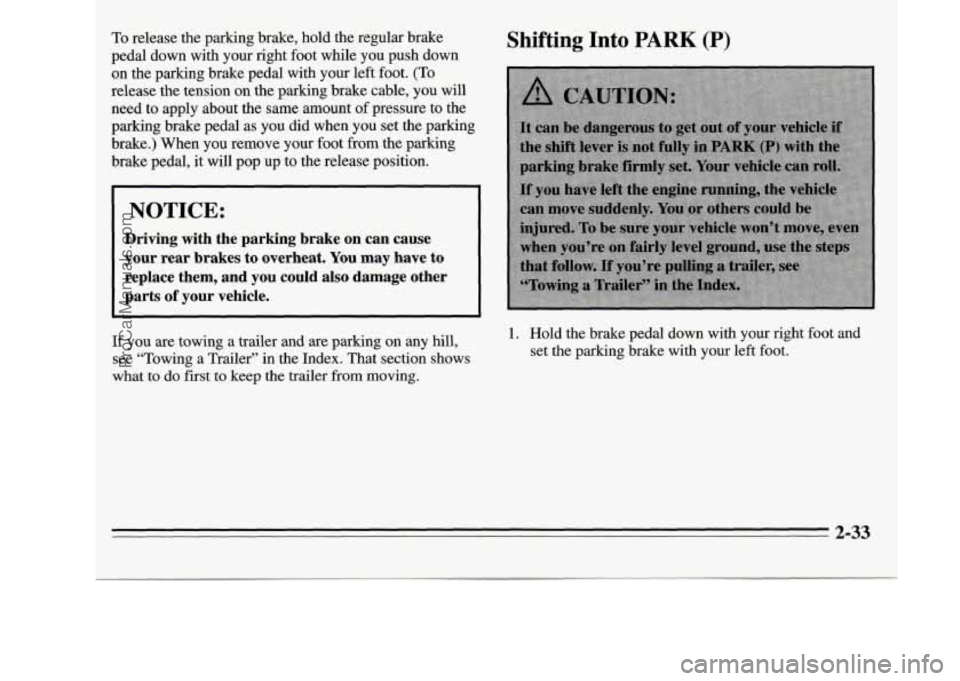
To release the parking brake, hold the regular brake
pedal down with your right foot while you push down
on the parking brake pedal with your left foot.
(To
release the tension on the parking brake cable, you will
need to apply about the same amount of pressure to the
parking brake pedal as you did when you set the parking
brake.) When
you remove your foot from the parking
brake pedal, it will pop up
to the release position.
I NOTICE:
Driving with the parking brake on can cause
your rear brakes to overheat.
You may have to
replace them, and
you could also damage other
parts
of your vehicle.
Shifting Into PARK (P)
If you are towing a trailer and are parking on any hill,
see “Towing a Trailer” in the Index. That section shows
1. Hold the brake pedal down with your right foot and
set the parking brake with
your left foot.
what to do first to keep the trailer
from moving.
2-33
ProCarManuals.com
Page 108 of 390
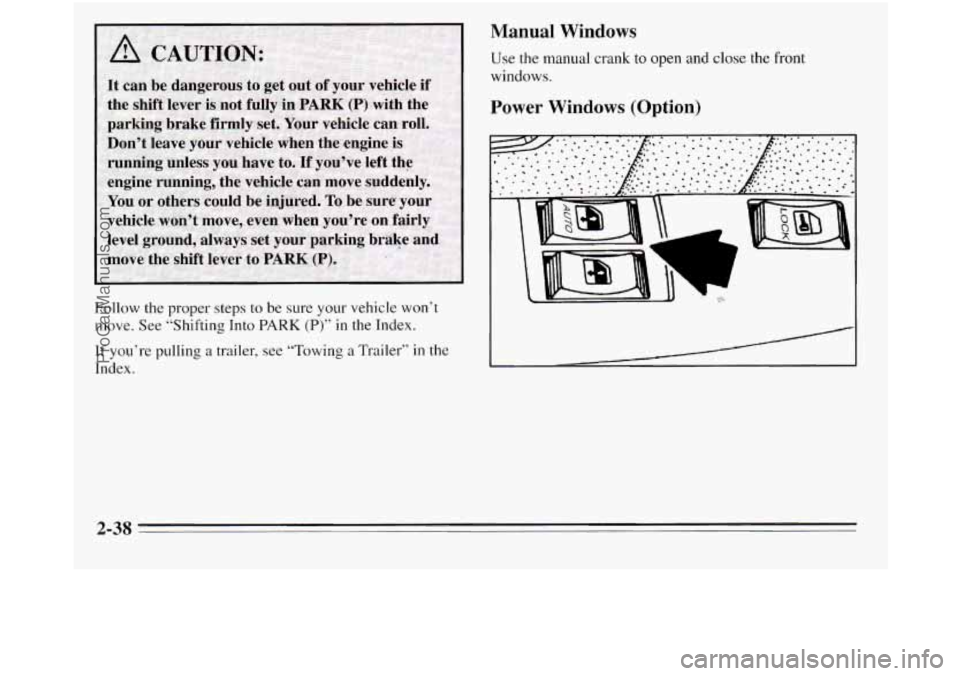
Follow the proper steps to be sure your vehicle won’t
move. See “Shifting Into PARK (P)” in the Index.
If you’re pulling a trailer, see “Towing a Trailer” in the
Index.
Manual Windows
Use the manual crank to open and close the front
windows.
?ower Windows (Option)
2-38
ProCarManuals.com
Page 111 of 390
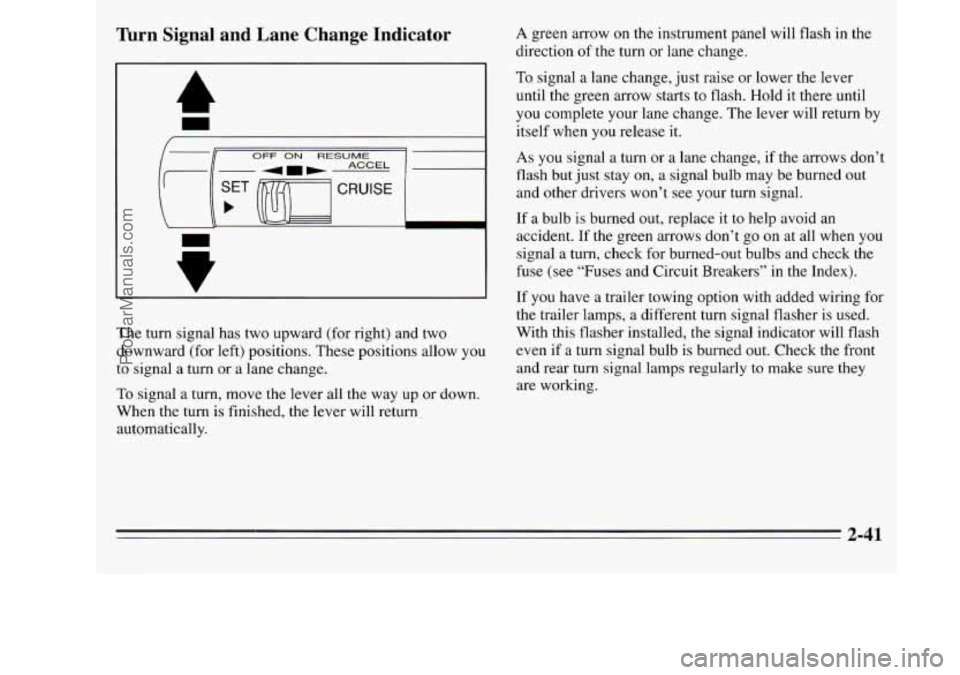
mrn Signal and Lane Change Indicator
OFF ON RESUME
The turn signal has two upward (for right) and two
downward (for left) positions. These positions allow you
to signal a turn or a lane change.
To signal a turn, move the lever all the way up or down.
When the turn is finished, the lever will return,
automatically.
A green arrow on the instrument panel will flash in the
direction
of the turn or lane change.
To signal a lane change, just raise or lower the lever
until the green arrow starts to flash. Hold it there until
you complete your lane change. The lever will return by
itself when you release it.
As you signal a turn or a lane change, if the arrows don’t
flash but just stay on, a signal bulb may be burned out
and other drivers won’t
see your turn signal.
If a bulb
is burned out, replace it to help avoid an
accident. If the green arrows don’t go on at all when
you
signal a turn, check for burned-out bulbs and check the
fuse
(see “Fuses and Circuit Breakers” in the Index).
If you have a trailer towing option with added wiring for
the trailer lamps, a different turn signal flasher is used.
With this flasher installed, the signal indicator will flash
even if
a turn signal bulb is burned out. Check the front
and rear turn signal lamps regularly
to make sure they
are working.
2-41
ProCarManuals.com
Page 148 of 390
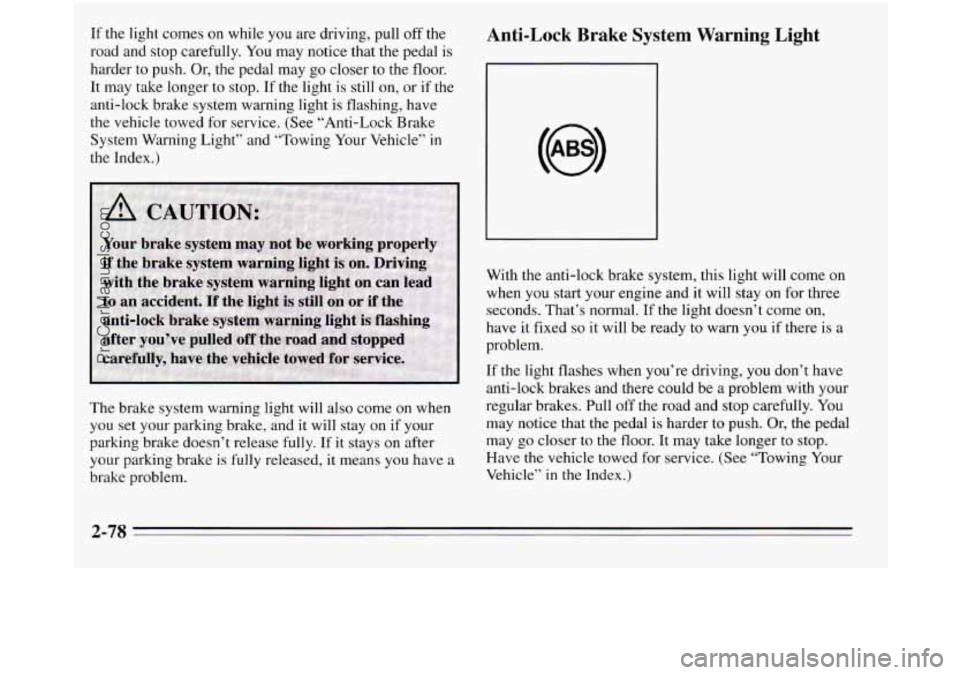
If the light comes on while you are driving, pull off the
road and stop carefully. You may notice that the pedal is
harder to push. Or, the pedal may go closer to the floor.
It may take longer
to stop. If the light is still on, or if the
anti-lock brake system warning light is flashing, have
the vehicle towed for service. (See “Anti-Lock Brake
System Warning Light” and “Towing Your Vehicle”
in
the Index.)
The brake system warning light will also come
on when
you set your parking brake, and it will stay on if your
parking brake doesn’t release fully. If it stays on after
your parking brake is fully released, it means you have a
brake problem.
Anti-Lock Brake System Warning Light
With the anti-lock brake system, this light will come on
when you start your engine and it will
stay on for three
seconds. That’s normal. If the light doesn’t come on,
have it fixed
so it will be ready to warn you if there is a
problem.
If the light flashes when you’re driving, you don’t have
anti-lock brakes and there could be
a problem with your
regular brakes. Pull
off the road and stop carefully. You
may notice that the pedal is harder to push. Or, the pedal
may go closer to the floor. It may take longer
to stop.
Have the vehicle towed for service. (See “Towing Your
Vehicle” in
the Index.)
2-78
ProCarManuals.com